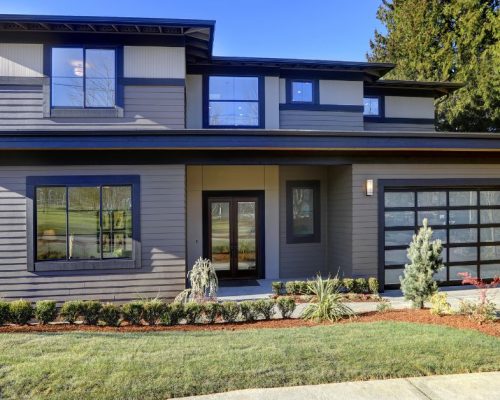If you’re a Californian homeowner, chances are you’ve seen or heard about low-slope roofs. But what exactly are they? Why are they so popular in the Golden State?
At Specialty Remodeling Inc, we’ve always believed that knowledge is power. And when it comes to the world of roofing, our decades of hands-on experience have provided us with more than a few insights.
Buckle up, folks, because today we’re diving deep into the world of Low-Slope Roofing for California Homes.
Benefits of Low-Slope Roofing
Low-slope roofing, often called “flat roofing” (even though it isn’t entirely flat), has been a favored choice for many homeowners and builders in various parts of the world, including sunny California. But why? What magic does this roofing style bring to a home? Let’s roll up our sleeves and delve deeper into the comprehensive benefits of low-slope roofing.
Cost-Efficiency: More for Less
Often, when homeowners hear “cost-efficient,” they think “cheap” or “low-quality.” But in the case of low-slope roofing, this couldn’t be farther from the truth. Due to the simplicity of its design and installation process, this roofing type is often more affordable to install than its steep-slope counterpart. But don’t let the price tag fool you – it doesn’t skimp on durability or performance.
Aesthetically Pleasing: Modern and Sleek
If you’re shooting for a modern or minimalist aesthetic for your home, then a low-slope roof can be your best ally. Its streamlined appearance complements contemporary home designs, offering a sleek and updated look. This roofing type refuses to overshadow other architectural features, instead working in harmony with the overall design.
Durability: Built to Last
With the right materials and proper installation, low-slope roofs can stand their ground against Mother Nature’s whims. Be it the scorching California sun, torrential downpours, or even an unexpected hailstorm, a well-maintained low-slope roof can weather the storm and serve you for years on end.
Space Utilization: A Bonus Room on Top
Remember that daydream you had about a rooftop garden, lounge, or even solar panels? With low-slope roofing, it’s all possible. The design naturally lends itself to additional living or utility spaces, granting homeowners the flexibility to create an outdoor oasis or a functional area tailored to their needs.
Safety and Accessibility: Easy Does It
When it’s time for routine maintenance, repairs, or upgrades, a low-slope roof shines bright. Thanks to its gentle pitch, it offers safer and more accessible working conditions. This means less potential for accidents and a quicker turnaround time for any roofing projects.
Energy Efficiency: Stay Cool, California!
A little-known fact about low-slope roofs is their energy efficiency prowess. With ample space to install thicker insulation, these roofs excel in maintaining a comfortable indoor temperature. Pair this with reflective roofing materials, and you’ve got yourself a home that stays cooler in the summer and warmer in the winter, all while potentially reducing your energy bills.
Versatility in Materials: Pick Your Winner
Whether you’re an advocate for eco-friendly materials like TPO or you lean towards the tried-and-tested built-up roofing, the world is your oyster when it comes to material choices for low-slope roofs. Each offers its own set of advantages, from durability to water-resistance and beyond.
In a nutshell, opting for a low-slope roof isn’t just a fleeting design trend. It’s a decision rooted in functionality, aesthetics, and long-term benefits. Whether you’re in sunny California or elsewhere, this roofing type might just be the unsung hero your home needs.
Popular Types of Low-Slope Roof Systems
For the uninitiated, the world of roofing might seem like a simple, one-size-fits-all kind of deal. However, when you dive deeper, especially into the realm of low-slope roofs, a diverse array of systems comes to light, each with its unique strengths and applications. Let’s embark on a journey through the landscape of popular low-slope roof systems to help you better understand their features and benefits.
Built-Up Roofing (BUR): The Time-Tested Classic
When people talk about “tar and gravel” roofs, they’re typically referring to BUR. A true stalwart in the roofing world, built-up roofing comprises:
- Layers upon Layers: This system uses alternating layers of bitumen (asphalt or coal tar) and reinforcing fabrics, creating a finished membrane.
- Durability: Thanks to its multi-layered structure, BUR provides excellent waterproofing and protection against minor physical damage.
- Versatility: Homeowners can choose between asphalt, cold-applied adhesive, or even hot-applied rubberized asphalt to bond the layers.
- Top Finish: The top layer is often sprinkled with gravel or mineral surfacing, offering an extra layer of protection against the elements and UV radiation.
Modified Bitumen Roofing: Flexibility at its Finest
Considered the modern evolution of the BUR system, modified bitumen roofing introduces newer technologies and materials to offer:
- Superior Flexibility: These roofing systems employ polymers (like APP or SBS) that grant the material added flexibility, especially in colder climates.
- Installation Choices: Whether torch-applied, cold-applied, or set in place with “peel-and-stick” self-adhesive, this system offers varied installation methods.
- Enhanced Performance: The modified bitumen sheets resist wear and tear, thermal shocks, and punctures, making them ideal for buildings exposed to fluctuating weather conditions.
Single-Ply Roofing: The Modern Marvel
As the newest entrant in the low-slope roofing arena, single-ply roofing systems offer a lightweight, yet durable, solution. They come in primarily two flavors:
- TPO (Thermoplastic Olefin): TPO is all the rage nowadays due to its eco-friendliness and energy efficiency. Its white reflective surface bounces back the sun’s rays, helping homes stay cooler. Plus, it’s resistant to UV rays, mold growth, and punctures.
- EPDM (Ethylene Propylene Diene Monomer): Often referred to as a rubber roof, EPDM is recognized by its dark surface. It’s incredibly durable, resisting UV radiation, hail damage, and extreme temperature fluctuations. This system can be ballasted, mechanically attached, or fully adhered, giving homeowners a range of installation choices.
Spray Polyurethane Foam (SPF): The Protective Shield
While not as commonly spoken about as the others, SPF is a formidable player in the world of low-slope roofing.
- Seamless Installation: SPF is sprayed directly onto the roof, where it expands and forms a solid layer across the entire roof, ensuring there are no seams or joints.
- Enhanced Insulation: Apart from being waterproof, SPF offers excellent insulation, reducing energy costs.
- Sustainability: Damaged or worn-out sections of an SPF roof can be re-coated rather than replaced, prolonging the roof’s life and reducing waste.
Essential Materials for Low-Slope Roofing
When it comes to low-slope roofing, the choice of materials can make or break the longevity and functionality of the roof. Selecting the right materials is paramount, not just for enduring California’s unique climate but also for ensuring optimal performance and minimal maintenance.
PVC (Polyvinyl Chloride)
PVC roofs are resistant to moisture, fire, and even those pesky UV rays. They’re a heavyweight in the roofing world and are known for their longevity.
TPO (Thermoplastic Olefin)
TPO is the new kid on the block but is quickly making a name for itself due to its energy efficiency and eco-friendliness.
EPDM (Ethylene Propylene Diene Monomer)
A mouthful, right? But trust us, it’s worth it. EPDM is known for its durability and flexibility. Plus, it’s one of the most water-resistant materials out there.
Best Practices for Low-Slope Roof Maintenance
A roof, while a critical component of any structure, is often overlooked until a problem rears its head. And when it comes to low-slope roofing, due diligence in maintenance can be the difference between a roof that serves you for decades and one that demands frequent, costly repairs. Let’s unpack the essential maintenance practices to ensure the longevity and peak performance of your low-slope roof.
Routine Inspections: Nip It in the Bud
Like a regular health check-up, your roof requires periodic inspections to catch potential issues early on.
- Frequency: At a minimum, inspect your roof bi-annually — in the spring and fall. However, after extreme weather events or any incident that could potentially cause damage (like a fallen tree branch), an immediate check-up is wise.
- What to Look For: Keep an eye out for pooled water, damaged or blistered areas, cracks, or any visible wear and tear. Also, check flashings, seams, and penetrations for any signs of damage or separation.
Debris Removal: Keep It Clean
An untidy roof isn’t just an eyesore; it’s a potential problem waiting to happen.
- Regular Cleaning: Ensure that your roof is free from accumulated debris like leaves, branches, and dirt. These can trap moisture, leading to mold growth or even structural damage.
- Drainage System: Clear out gutters, downspouts, and drains to prevent water logging. Remember, proper water flow is crucial for low-slope roofs.
Prompt Repairs: Don’t Sleep on It
If you spot a problem, address it. Procrastinating on roof repairs can quickly escalate the issue and the cost.
- Professional Help: While some minor issues can be a DIY project, it’s always recommended to seek the expertise of a professional for more extensive repairs. They can properly diagnose the problem and provide a long-lasting solution.
- Sealing and Caulking: Over time, sealants can deteriorate. Regularly check and reseal areas around vents, chimneys, and other roof penetrations to prevent leaks.
Mind the Foot Traffic: Tread Lightly
For roofs that are frequently accessed (maybe you’ve got that dreamy rooftop garden!), foot traffic can be a concern.
- Limit Access: Only allow access when necessary. Every step can wear down the roofing material, especially if the roof isn’t designed for regular foot traffic.
- Protective Measures: Consider using walk pads or designated walkways. These provide a safe path for foot traffic while protecting the roof from unnecessary wear and tear.
Stay Vigilant After Installations
Got a new satellite dish, HVAC unit, or solar panel installation? Anytime there’s work done on or near your roof, inspect afterward.
- Potential Damage: Installations can sometimes inadvertently damage the roofing membrane. It’s always a good practice to check the roof after any significant work to ensure its integrity remains intact.
Documentation: Keep a Roofing Diary
Documenting your roof’s history can be invaluable, especially when addressing warranties or if you’re considering selling your property.
- Maintenance Log: Keep a record of all inspections, repairs, installations, and any other work done on the roof. Include dates, work descriptions, and any professionals or companies involved.
At the end of the day, a well-maintained low-slope roof is a long-lasting one. By following these best practices, not only do you ensure the longevity of your roof, but you also guarantee peace of mind, knowing that the roof over your head is in its prime condition, come rain or shine.
A Roof Above the Rest with Specialty Remodeling Inc.
Your home deserves the best. At Specialty Remodeling Inc, we pride ourselves on offering top-tier roofing solutions tailored to California’s unique climate and needs. Whether you’re considering a low-slope roof or just need some expert advice, our seasoned team is here to guide you every step of the way. So why wait? Call us or set an appointment with us today and elevate your home to new heights. After all, it’s not just a roof; it’s a statement.




